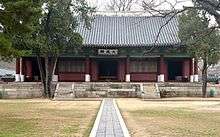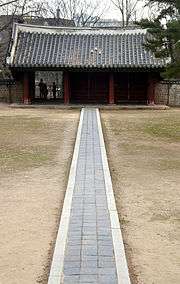Munmyo
Munmyo (more specifically Seoul Munmyo or Seonggyungwan Munmyo) is Korea's primary temple of Confucius ("munmyo" is also the general Korean term for a temple of Confucius). It is located in central Seoul, South Korea, at 53 Myeongnyun-dong 3(sam)-ga, Jongno District, on the campus of Sungkyunkwan University.
| Munmyo | |
 Daeseongjeon in Munmyo | |
| Korean name | |
|---|---|
| Hangul | 문묘 |
| Hanja | |
| Revised Romanization | Munmyo |
| McCune–Reischauer | Munmyo |
Munmyo houses a shrine to Confucius known as Daeseongjeon, or "Hall of Great Achievement." The main gate leading to the shrine Sinsammun, literally "Spirit Three Gate", is open only on special occasions such as Seokjeon Daeje. The central gate is reserved for the spirit of Confucius and his disciple, and no one else may enter through this gate. Past this gate is the central path that leads to Daeseongjeon, and visitors may not cross this path, especially during a ceremony when the gates are open.[1] The courtyard is used for the Seokjeon Daeje ceremony. Munmyo also contains two other halls (Dongmu and Seomu, east and west hall), two dormitories (Dongjae and Seojae, east and west dormitories), a Confucian lecture hall called Myeongnyundang, a library called Cheonggyeongdang, and Jinsasikdang which is the dining hall.[2][3]
History

The Munmyo is based on Confucian practices from China, where Confucius and followers of his teachings were honored and venerated. Temples dedicated to Confucius and other disciples called "temples of Confucius" became widespread during the Tang dynasty. This idea was brought to Korea where it was adopted.
Present Day
A ritual called Munmyo jerye (Hangul: 문묘제례; hanja: 文廟祭禮) or Seokjeon Daeje, which involves music and dance, is held there each year in the spring (April) and autumn (September); the ritual features ancient music of Chinese origin called Munmyo jeryeak (Hangul: 문묘제례악; hanja: 文廟祭禮樂), which is a form of aak. (In the chronological order of enshrinement) Choe Chiwon, Seol Chong, An Hyang, Jeong Mong-ju, Kim Gweong-pil, Jeong Yeo-chang, Jo Gwang-jo, Yi Eon-jeok, Yi Hwang, Yi I, Seong Hon, Kim Jang-saeng, Song Si-yeol, Song Jun-gil, Pak Se-chae, Kim Inhu, Jo Hun, and Kim Jip.
The musicians are provided by the National Gugak Center. The instruments used include flutes (hun, so, and bamboo flutes), zithers (seul and geum), stone chimes (pyeongyeong), bronze bells (pyeonjong), various drums played with sticks, tiger-shaped wooden scraper (eo), wooden box (chuk), and wooden clappers (bak).
Munmyo is designated by the South Korean government as Historic Site No. 143.
See also
References
- "Confucian ceremony at Seonggyungwan Munmyo". Korea.net. March 24, 2015.
- An Byung-ju. "Sunggyun-gwan, Sanctuary of Confucianism in Korea". Korana.
- "Munmyo Shrine". Parandeul.
| Wikimedia Commons has media related to Munmyo. |
External links
- Sung Kyun Kwan University
- Asian Historical Architecture: Munmyo Confucian Shrine
- "Rare Confucian Musical Ritual at NCKTPA", by Kim Ju-young, from The Korea Times